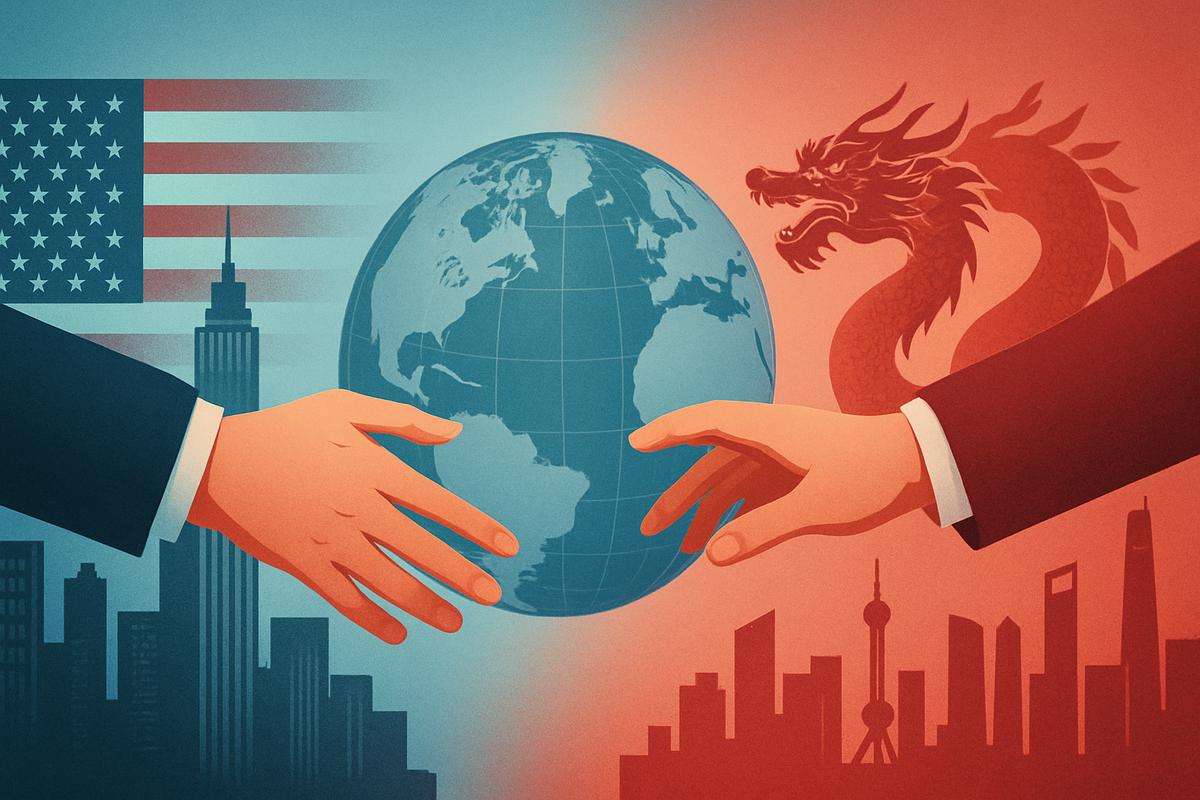
Busan, South Korea – October 30, 2025 – Global financial markets are experiencing a significant uplift today following the announcement of a pivotal trade truce between the United States and China. US President Donald Trump and Chinese President Xi Jinping, meeting at the Asia-Pacific Economic Cooperation (APEC) Summit in Busan, South Korea, confirmed a "framework deal" aimed at de-escalating a protracted and often volatile trade dispute. This unexpected consensus has sent a wave of cautious optimism across international bourses, particularly in the sensitive markets of Asia and Europe, offering a temporary reprieve from escalating tariff threats and geopolitical tensions.
The agreement, which includes immediate tariff reductions, China's commitment to resume purchases of US agricultural products, and a one-year suspension of China's rare earth export curbs, marks a crucial turning point after months of friction. While hailed by both leaders as a significant step forward, analysts are quick to characterize it as a tactical pause rather than a complete resolution, suggesting that the underlying structural issues in the US-China economic rivalry remain largely unaddressed. Nevertheless, for now, investors are embracing the respite, hoping this fragile peace can pave the way for more sustained economic stability.
A Year of Turmoil Culminates in Cautious Optimism
The path to today's trade truce has been fraught with intense negotiations, retaliatory measures, and significant market volatility over the past two years. Since Donald Trump's return to office on January 20, 2025, trade relations between the world's two largest economies have been a rollercoaster of escalation and de-escalation. His administration quickly reignited scrutiny of trade deficits and alleged unfair practices, setting the stage for renewed tensions.
Key events leading to this moment include the US imposition of a 10% tariff on all Chinese imports in February 2025, specifically targeting fentanyl precursor chemicals, which China swiftly countered with 15% tariffs on US energy and agricultural products. This exchange rapidly escalated, with US tariffs on Chinese goods reaching a cumulative 145% by April 2025, met by Chinese retaliatory tariffs up to 125%. A brief period of de-escalation occurred in May 2025, when both nations temporarily lowered tariffs for three months to facilitate broader talks, with the US reducing its tariffs to 30% and China cutting its to 10%. However, tensions flared again in October 2025 when President Trump threatened new 100% tariffs on Chinese imports, effective November 1, in response to China's expanded export controls on rare earth elements. This aggressive stance, coupled with a Section 301 investigation launched by the Office of the US Trade Representative (USTR) into China’s implementation of the Phase One trade deal, brought the global economy to the brink of another full-blown trade war.
The breakthrough came after intensive, high-level discussions in Kuala Lumpur, culminating in a "framework" for a trade deal announced on October 26, 2025. This laid the groundwork for the face-to-face meeting between Presidents Trump and Xi at the APEC Summit. The resulting agreement sees the US reducing its import duties on Chinese goods from 57% to 47% and suspending a 24% reciprocal tariff for another year. China, in turn, has committed to easing its rare earth export restrictions for 12 months and resuming purchases of US agricultural products, particularly soybeans. This immediate de-escalation has been met with relief across global markets.
Initial market reactions have been overwhelmingly positive. Prior to the truce, European financial markets closed sharply lower on October 10, 2025, as escalating trade disputes sent shockwaves across the continent. However, the news of the impending deal and the subsequent announcement sparked a significant rally. On October 27, 2025, Asian markets surged, with Japan's Nikkei 225 (TYO: N225) crossing the 50,000 level for the first time, rising 2.1%. South Korea's Kospi (KRX: KOSPI) gained approximately 2%, while Hong Kong's Hang Seng Index (HKG: HSI) climbed 1% and Shanghai's Composite Index (SHA: 000001) advanced 0.9%. European equity markets also saw a positive shift, with futures indicating a firmer open and the EUR/USD currency pair increasing due to relaxed trade tensions. This immediate bounce underscores the market's profound sensitivity to US-China trade dynamics and its hunger for stability.
Winners and Losers in the Trade Truce Landscape
The immediate de-escalation of US-China trade tensions is poised to create distinct winners and losers across various sectors and companies, particularly those with significant exposure to international trade flows and global supply chains. The most apparent beneficiaries are multinational corporations that rely heavily on both the US and Chinese markets for revenue, manufacturing, or sourcing. Companies like Apple Inc. (NASDAQ: AAPL), which has extensive manufacturing operations in China and a vast consumer base there, will likely see reduced pressure on their supply chains and potentially lower costs of goods sold due to tariff reductions. Similarly, semiconductor giants such as Qualcomm Inc. (NASDAQ: QCOM), which was recently under investigation by China, could breathe a sigh of relief as the threat of further restrictions diminishes, allowing them to maintain critical market access and supply to Chinese tech firms.
The agricultural sector, particularly in the United States, stands to gain significantly from China's commitment to resume purchases of US agricultural products, including soybeans. This will provide much-needed support to American farmers who have been severely impacted by previous retaliatory tariffs. Companies involved in agricultural commodities trading and processing, such as Archer Daniels Midland Company (NYSE: ADM) and Bunge Limited (NYSE: BG), could see increased demand and improved margins. European companies with substantial export ties to China, especially in luxury goods, automotive, and industrial machinery, may also experience a boost in investor confidence and sales, as the overall global trade environment becomes less volatile.
However, the "tactical pause" nature of this truce suggests that some companies might face continued uncertainty or even strategic disadvantages. Businesses that had begun to diversify their supply chains away from China or the US in anticipation of prolonged trade friction might find their investments in new manufacturing hubs or alternative sourcing more costly in the short term, though potentially beneficial in the long run. Furthermore, companies that have benefited from trade diversion or increased domestic production due to tariffs might see their competitive edge erode if tariffs remain lower. Rare earth element producers outside of China, who might have anticipated increased demand as China restricted exports, could see their market opportunities temporarily constrained by China's one-year suspension of export curbs. The long-term winners will likely be those agile enough to adapt to both periods of tension and periods of fragile peace, maintaining diversified strategies and strong relationships across multiple markets.
Broader Implications and Historical Context
The latest US-China trade truce, while a welcome development for markets, fits into a broader pattern of geopolitical and economic rivalry that extends far beyond tariffs. This event underscores the ongoing struggle for technological supremacy, influence over global supply chains, and adherence to international trade norms. The easing of tensions, even temporarily, has significant ripple effects. For competitors, it means a more stable, albeit still competitive, global trade environment. Companies that had been considering aggressive reshoring or nearshoring strategies might now pause to reassess, balancing the costs of relocation against the potential for continued access to the efficient Chinese manufacturing base. Partners in global supply chains, from raw material suppliers to logistics providers, will likely see a return to more predictable demand patterns, reducing some of the operational uncertainties that have plagued them.
Regulatory and policy implications are also substantial. The agreement on rare earth exports and agricultural purchases suggests a willingness from both sides to engage in specific, actionable commitments. This could set a precedent for future negotiations on more complex issues, such as intellectual property rights, state subsidies, and cyber security. However, the underlying legislative tools that enabled the tariff escalations, such as Section 301 and Section 232 investigations in the US, remain in place, indicating that future tensions are still possible. Historically, trade disputes between major economic powers have often been protracted and characterized by periods of intense negotiation followed by fragile agreements. The current situation bears some resemblance to the US-Japan trade disputes of the 1980s, where tensions over automotive and electronics trade led to voluntary export restraints and managed trade agreements, ultimately shaping global industrial landscapes. The key difference today is the sheer scale and interconnectedness of the US and Chinese economies, making any disruption far more globally impactful. This truce, therefore, should be viewed as a pause in an ongoing strategic competition, rather than a definitive end to trade friction.
What Comes Next: Navigating the Uncertain Path Ahead
Looking ahead, the immediate short-term possibility is a period of relative calm in global trade, allowing businesses to plan with slightly greater certainty. Investors will closely watch for the formal signing of the "framework deal" and its implementation details. China's adherence to its commitments, particularly regarding agricultural purchases and rare earth export policies, will be a critical indicator of the truce's durability. In the long term, however, the fundamental issues driving US-China trade tensions—including technological competition, intellectual property disputes, and differing economic models—are unlikely to disappear. This suggests that future periods of friction are highly probable, necessitating strategic pivots and adaptations from businesses worldwide.
Potential strategic adaptations include continued diversification of supply chains, with companies adopting a "China plus one" or "regional hub" strategy to mitigate risks. Market opportunities may emerge for countries and companies that can offer alternative manufacturing bases or secure access to critical resources, positioning themselves as reliable partners in a less China-centric global economy. Conversely, challenges will persist for industries heavily reliant on single-source inputs or markets, pushing them towards greater resilience. Potential scenarios range from a gradual, managed de-escalation where both sides find common ground on specific issues, to a return to aggressive tariff measures if either party perceives a lack of compliance or renewed provocation. A "decoupling light" scenario, where certain strategic sectors (e.g., advanced semiconductors, AI) see continued restrictions while broader trade flows remain open, is also a strong possibility. The outcome will largely depend on the political will of both administrations to prioritize economic stability over nationalistic protectionism.
A Fragile Equilibrium in a Dynamic World
Today's US-China trade truce offers a crucial moment of respite for global markets, providing a much-needed injection of optimism after a tumultuous period. The immediate tariff reductions and commitments on agricultural purchases and rare earth exports represent significant, albeit temporary, de-escalations. The surge in Asian and European markets underscores the profound impact of US-China relations on global investor sentiment and economic performance.
Moving forward, the market will be assessing the sustainability of this truce. Key takeaways include the realization that trade relations remain highly fluid and politically charged, and that the underlying structural issues are far from resolved. Investors should watch for concrete implementation of the agreed-upon terms, any new statements or policy shifts from either Washington or Beijing, and indicators of economic growth and stability in both the US and China. The long-term trajectory of US-China relations will continue to be a defining factor for global economic health, demanding vigilance and adaptability from businesses and investors alike. While the immediate outlook is brighter, the landscape remains one of fragile equilibrium in a dynamic and ever-evolving geopolitical environment.
This content is intended for informational purposes only and is not financial advice.






